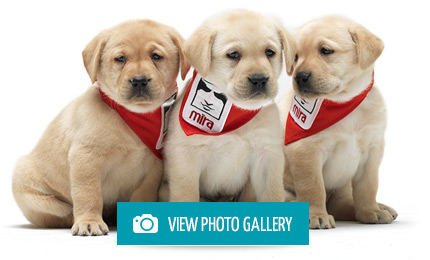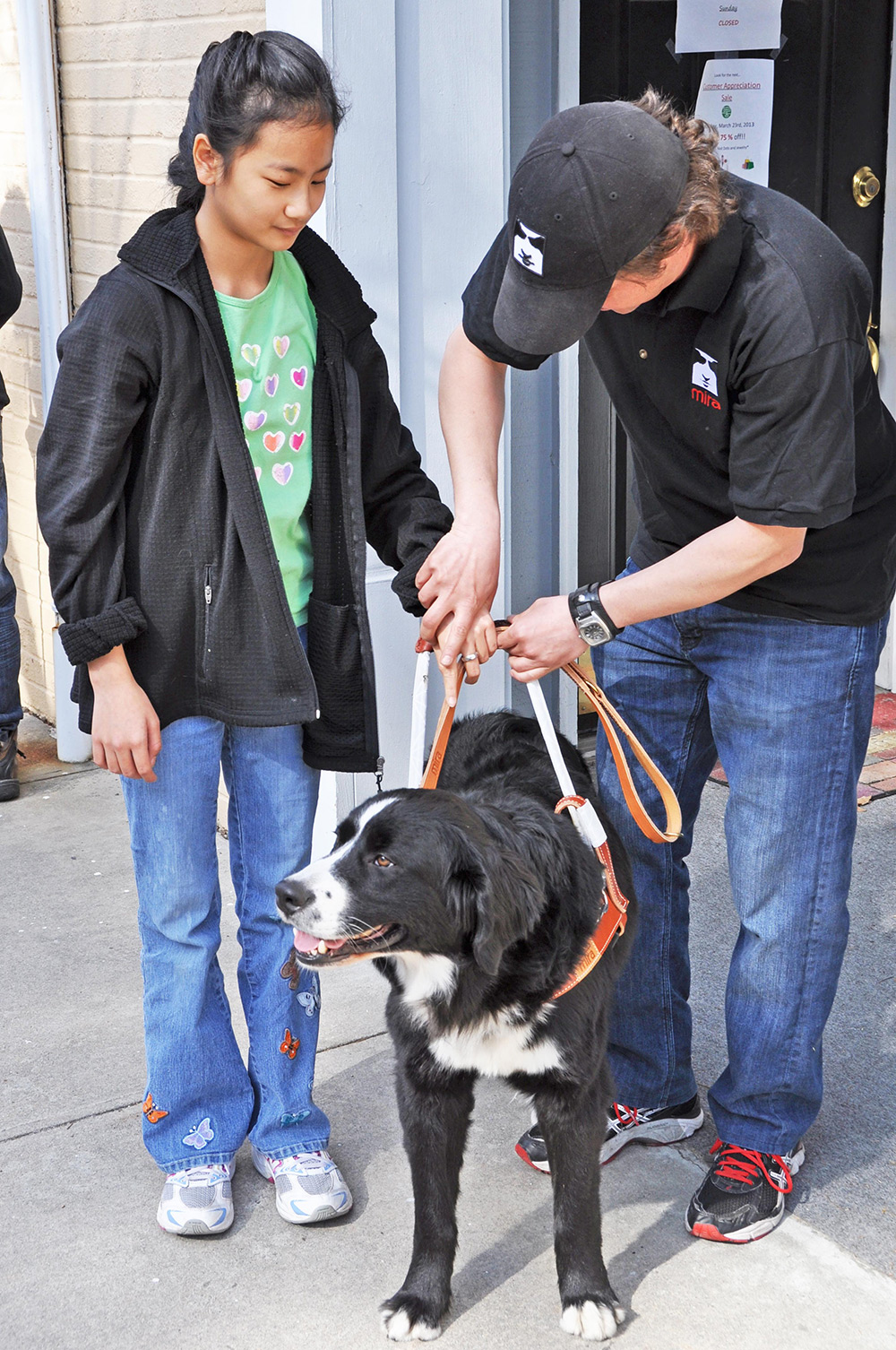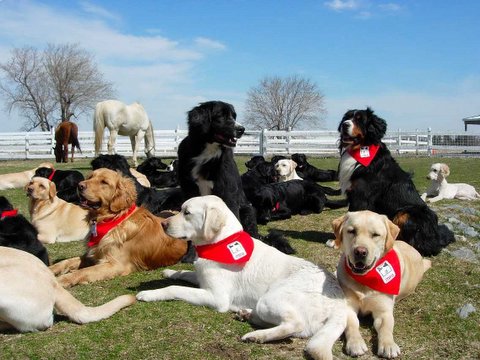Our Dogs
-
 At the Mira Foundation in Canada, where Mira Guide Dogs are bred, the specialized breeding results in the qualities that are needed in a guide dog.
At the Mira Foundation in Canada, where Mira Guide Dogs are bred, the specialized breeding results in the qualities that are needed in a guide dog.
Each year, Mira Canada assists at the breeding and birth of more than 300 puppies. Mira Canada mainly works with Labrador, Bernese Mountain dogs, the labernese and the Saint-Pierre labernese, which is a second generation labernese. Physically, it has a black and white coat with long hair and a white line leading down from forehead to muzzle. Like its ancestor the labernese, the Saint-Pierre shares the qualities of the Labrador and Bernese Mountain dog in equal parts, making it an excellent guide and assistant for all Mira beneficiaries.The mixing of these two breeds gives an excellent breed which we call the Saint-Pierre labernese
Mira Canada takes extensive time and care to purify the lineage and manage the production of an excellent guide dog. The goal is to look for the best physical and behavioral features in a dog to ensure that they are healthy and compatible with the needs necessary for an intelligent guide dog.
For at least a year, the puppies are placed in foster homes for socialization and training. The dogs are followed every 3 months by the staff and come back to Mira Canada regularly for health and behaviour follow-ups. After a year with their foster families, the dogs are brought back to Mira Canada for evaluation. Physical and psychological factors such as aggressiveness, fear and excessive activity are ruled out. The choosing of dogs that will become guide dogs is extremely selective. Only a small percentage of dogs are deemed qualified in terms of temperament and intelligence to be trained as guide dogs.
-
 The Mira guide dogs are trained by experienced dog trainers for a period of 8 months.
The Mira guide dogs are trained by experienced dog trainers for a period of 8 months.The dog learns to obey commands, walk in straight lines, and avoid objects and situations that might prove dangerous to blind persons. They are taught not to be distracted by people, food, etc. They learn to stop safely before stepping into a street, lead people to doors and point their noses at the knobs, safely navigate stairs. They learn to look for overhead obstructions such as low tree branches ad signs, to walk through crowds carefully. They develop a sense of “intelligent disobedience” in which they learn to disobey a command if it would result in a dangerous situation. The training for guide dogs who work with our children is the most extensive of all training. And note, Our guide dogs are trained off leash….the dogs are taught to stay by the side the child at all times when working. If the child drops the harness or leash, the dog will stay in place. The training is extremely strict and intense and it is fascinating to see.
It is important to recognize that these dogs are not pets. They are furry and wonderful but they have another vital responsibility. They are trained professional guide dogs and are extremely competent. They are guardians, companions and provide a path to increased independence.
When matching a guide dog with a student, many factors are considered: the personality of the child, the temperament of the dog, the size and potential growth of child, the strength of the child, the size of the dog, the responsiveness of the child and the dog. It is a carefully orchestrated process that has been developed and used successfully for over twenty five years. Mira USA is extremely fortunate to have this experience from Mira Canada as we implement our program of providing guide dogs for youngsters here in the United States.
-
About our Mira Guide Dogs

It is a carefully orchestrated process that has been developed and used successfully for over fourty years. Mira USA is extremely fortunate to have this experience from Mira Canada as we implement our program of providing guide dogs for youngsters here in the United States.
The youngster who receives a dog
must be the only one who takes care of the dog.This is important so that the dog and the youngster bond completely. The youngster walks the dog, brushes the dog, take care of the dog’s food and the dog’s elimination needs. The bond that develops is amazing, but it is also takes a good deal of work. The dog must obey the child and the child must be alert to the dog’s needs. But of course, the dog is also a dog and needs some “down” time. Some play time, in a safe place, when the dog is not in harness and not on leash, is important each day. Our dogs do run and play, they scamper and roll and enjoy their play time. But, when in harness, the dog is working and must always be ready to guide the child.
An interesting point is that the dogs are taught intelligent disobedience.
If the child gives a command that would put the child in danger, the dog is taught not to obey. It is amazing to watch this happen and certainly gives additional peace of mind to the youngster and to the parents and guardians. An example of this would be a guide dog not crossing a street if there was danger involved.
These dogs are beautiful.

They attract people who stop and talk and want to pet them. At this point, the youngster must be alert and tell even kind people, even family members and friends, that the dog is working. Guide dog etiquette requires that people should not talk to or pet the dog while the dog is working. People must ask the youngster’s permission before talking to or petting the dog. Our children are taught to be very strict about this and school personnel as well as family members have learned to respect this.
Bob has a sign on DJ’s harness that says, “Please ask me before you touch him.” This is very important.
Working with a guide dog takes incredible trust on the part of the youngster (and the parents and guardians.) Yet, the trainers are truly remarkable experts who kindly and gently teach what one needs to know about working with and having a Mira Guide Dog.

